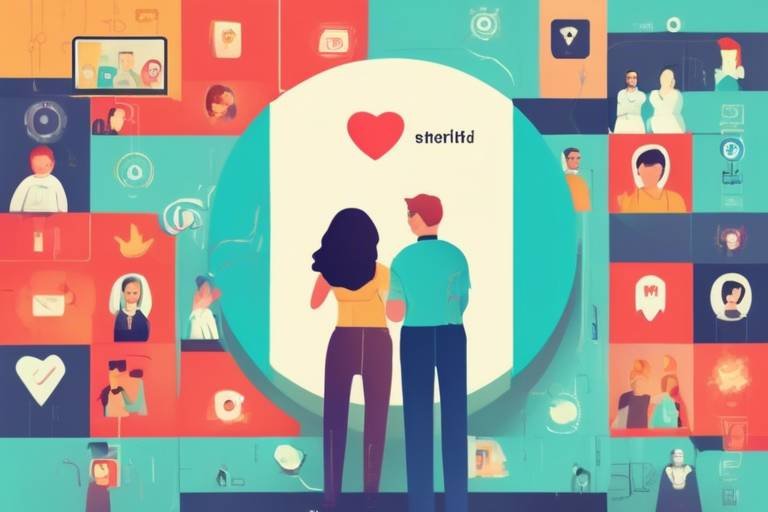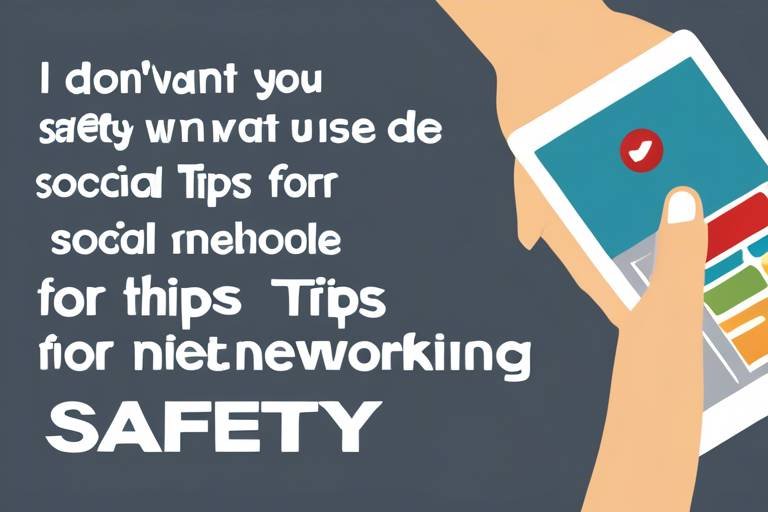How Social Networks can Compromise Your Privacy?
In today's digital age, social networks have become an integral part of our daily lives, connecting us with friends, family, and even strangers across the globe. While these platforms offer numerous benefits, they also come with significant risks to our privacy. Have you ever stopped to think about how much personal information you share on these sites? From your location to your thoughts and feelings, everything is up for grabs. In this article, we’ll dive deep into the various ways social networks can compromise your privacy, and what you can do to protect yourself in this ever-evolving digital landscape.
First and foremost, it's essential to understand that social networks are designed to encourage sharing. This means that the more you interact, the more data they collect. You might think that posting a simple status update or sharing a photo is harmless, but the reality is that each click and interaction is meticulously logged. This data collection can lead to unwanted exposure and, in some cases, data breaches that put your personal information at risk. So, how can you safeguard your privacy in this environment?
One of the most effective ways to protect your personal information is by adjusting your privacy settings. Most social networks offer a range of privacy options that allow you to control who sees your content. However, many users overlook these settings, leaving their profiles wide open to the public. By taking a few moments to review and customize your privacy settings, you can significantly reduce the risk of your information falling into the wrong hands. Remember, it’s better to be proactive than reactive when it comes to your privacy!
Furthermore, let’s not forget about the role of data mining. Social networks employ sophisticated algorithms to analyze user behavior and preferences. This means that every like, share, and comment can be used to build a detailed profile of you. While this information can be useful for targeted advertising, it raises serious questions about consent and privacy. Are you comfortable knowing that your data is being harvested and sold to third parties? It’s crucial to be aware of how your information is being used and to take steps to limit its exposure.
Another area of concern is the use of third-party applications. Many social networks allow external apps to integrate with their platforms, which can be convenient but also risky. These apps often require access to your personal information, and not all of them have robust security measures in place. When you grant access, you may inadvertently expose your data to unauthorized parties. Always read the permissions requested by these apps and consider whether the convenience is worth the potential privacy risk.
Location tracking is yet another significant privacy concern. When you share your location on social networks, you might be inviting unwanted attention. Imagine posting a photo from a restaurant you frequent—now anyone can track your movements. This can lead to various dangers, including stalking or harassment. It’s vital to think twice before tagging your location, especially in public spaces.
Moreover, targeted advertising on social networks poses a unique challenge to user privacy. Advertisers use your personal data to create tailored ads, which can feel invasive. Have you ever noticed ads that seem eerily relevant to your recent conversations? This is no coincidence; it’s a result of data mining and analysis. While some may appreciate personalized ads, others may find it unsettling. Understanding how your data fuels these marketing strategies is essential for maintaining your privacy.
Lastly, let’s touch on the alarming trend of social engineering threats. Cybercriminals are becoming increasingly savvy at using social networks to manipulate users into revealing sensitive information. These tactics can range from phishing scams to impersonation. It’s crucial to remain vigilant and skeptical of unsolicited messages or friend requests, as they may be attempts to exploit your trust.
In conclusion, while social networks offer a platform for connection and expression, they also pose significant risks to our privacy. By understanding the various ways your information can be compromised, you can take proactive measures to protect yourself. Remember to adjust your privacy settings, be cautious with third-party apps, and stay aware of the potential dangers lurking in the digital shadows. Your personal information is valuable—treat it that way!
- What are privacy settings and why are they important? Privacy settings are configurations that allow you to control who can see your information on social networks. They are crucial for protecting your personal data from unwanted exposure.
- How can I protect my data from third-party applications? Always review the permissions requested by third-party apps and consider whether the convenience is worth the potential risks. Limit access to only essential information.
- What should I do if I suspect a data breach? If you suspect a data breach, change your passwords immediately and monitor your accounts for any suspicious activity. You may also want to enable two-factor authentication for added security.

Understanding Privacy Settings
In today's digital world, where social networks dominate our communication, understanding privacy settings is more crucial than ever. These settings are like the locks on your front door; they determine who can enter your space and what they can see. Most social media platforms offer a variety of options that allow you to control your personal information, but many users overlook these features. This oversight can lead to unwanted exposure of sensitive data, making it essential to familiarize yourself with the available privacy settings.
Let's break it down a bit. When you create an account on a social network, you're often prompted to fill out a profile with details such as your name, birthday, and even your location. But have you ever stopped to think about who can see that information? By default, many platforms set your profile to public, which means anyone—friends, strangers, or even potential employers—can view your details. To avoid this, you should regularly review and adjust your privacy settings to limit the visibility of your personal information.
Most platforms categorize their privacy settings into several sections, including profile visibility, friend requests, and post visibility. Here’s a quick overview of what to look for:
| Privacy Setting | Description |
|---|---|
| Profile Visibility | Controls who can see your profile information. |
| Friend Requests | Determines who can send you friend requests. |
| Post Visibility | Sets who can see your posts and updates. |
| Tagging Options | Allows you to control who can tag you in photos or posts. |
Adjusting these settings can significantly enhance your privacy. For instance, setting your profile to "Friends Only" or "Private" ensures that only those you trust can see your information. Additionally, consider disabling location sharing features, which can inadvertently disclose your whereabouts to anyone who views your profile.
Another important aspect is to regularly review your friend list and remove any connections that no longer feel appropriate. Just like cleaning out your closet, maintaining a curated list of friends can help you feel more secure about your online presence. Remember, social networks are designed to encourage sharing, but that doesn’t mean you should share everything with everyone.
Lastly, don't forget about the apps that you allow to connect with your social media accounts. These third-party applications often require access to your profile information, and they can sometimes bypass your privacy settings. Always read the permissions requested by these apps and consider whether you truly need them. If not, revoke their access to protect your personal information further.
In conclusion, understanding and adjusting your privacy settings on social networks is an essential step in safeguarding your personal information. By taking the time to explore these features, you can create a safer online environment for yourself and minimize the risks associated with sharing your data. So, take a moment today to dive into your privacy settings—you might be surprised by what you discover!

The Role of Data Mining
Data mining plays a pivotal role in how social networks operate, often lurking in the shadows of our online interactions. But what exactly is data mining? In simple terms, it’s the process of analyzing vast amounts of data to uncover patterns and insights. Social networks, with their treasure troves of user-generated content, are prime targets for this practice. They collect everything from your likes and shares to your comments and messages, creating a detailed profile of who you are. This can be both fascinating and frightening!
Imagine walking into a store where every product is tailored just for you, based on your past purchases and preferences. That’s the power of data mining in social networks. They leverage algorithms to predict your interests, making your experience more personalized. However, this personalization often comes at the cost of your privacy. When you share a post or click on an advertisement, you're not just interacting; you're feeding the machine that collects your data.
But how does this affect your privacy? Let’s break it down:
- Informed Consent: Most users are unaware of how their data is being used. When you sign up for a social network, you often agree to terms and conditions without fully understanding the implications. This lack of informed consent raises ethical concerns.
- Data Ownership: Who really owns the data? Is it you, the user, or the platform that collects it? This question remains murky, and users often feel powerless over their own information.
- Targeted Manipulation: With detailed profiles, social networks can create highly targeted advertisements. While this can be beneficial for businesses, it can also lead to manipulative marketing tactics that exploit your vulnerabilities.
Moreover, the implications of data mining extend beyond just advertising. It can influence everything from the news articles you see to the friends suggested to you. This can create echo chambers, where your beliefs and opinions are reinforced, limiting exposure to diverse perspectives. You might find yourself wondering, “Am I really seeing the full picture, or just a curated version of reality?”
In essence, while data mining enhances user experience on social networks, it also raises significant privacy concerns. The challenge lies in finding a balance between personalized services and protecting user privacy. As users, it's crucial to stay informed about how our data is being used and to take proactive steps to safeguard our information.

Third-Party Applications
In today's digital landscape, third-party applications have become a staple for enhancing our social media experiences. However, while they may offer fun features and conveniences, they also come with a significant risk to your privacy. When you connect a third-party app to your social network, you're essentially handing over a key to your personal information. This can include your profile details, friend lists, and even your activity logs. It’s like inviting someone into your home and then giving them access to your entire life! But how does this happen, and what can you do about it?
Many users may not realize that when they authorize an app, they often agree to share a wide array of data without fully understanding the implications. For instance, a seemingly harmless quiz app might request access to your friends list and personal details, which can then be used for targeted advertising or even sold to other companies. This is where the concept of data sharing comes into play. It’s crucial to scrutinize what permissions an app is asking for before clicking that 'Allow' button.
Moreover, not all third-party applications are created equal. Some may have robust privacy policies and security measures in place, while others may be outright shady. To illustrate this further, let’s take a look at a simple comparison:
| Application | Privacy Policy Quality | Security Features |
|---|---|---|
| QuizMaster | Basic | None |
| PhotoEnhancer | Comprehensive | Encryption |
| FitnessTracker | Moderate | Two-Factor Authentication |
As you can see from the table, the quality of privacy policies and security features can vary significantly among different applications. This means that users must be vigilant and conduct their own research before integrating any third-party service into their social media accounts. Always look for applications that are transparent about their data practices and offer strong security measures. After all, your personal data is your digital currency, and you wouldn’t want to give it away for free!
Another aspect to consider is the potential for unauthorized access. If a third-party application is compromised, it can lead to a data breach that exposes your personal information to malicious actors. This is particularly concerning if the app has access to sensitive data, such as your location, messages, or even financial information. It’s like leaving your front door wide open while you go on vacation—anyone can waltz in and take what they want!
To protect yourself, it's advisable to regularly review the applications linked to your social media accounts. Most platforms allow you to manage your connected apps in the settings section. If you find an app that you no longer use, or one that raises red flags, don’t hesitate to remove it. Additionally, consider using privacy-focused alternatives that prioritize user data protection. Remember, being proactive about your digital privacy can save you from potential headaches down the line.
In conclusion, while third-party applications can enhance our online experience, they also pose significant risks to our privacy. By understanding the implications of granting access to these apps, users can take informed steps to protect their personal information. Always be cautious, do your homework, and don’t let convenience overshadow your privacy!
- What should I look for in a third-party application? Always check the privacy policy, permissions requested, and user reviews before connecting.
- How can I remove unwanted third-party applications? Navigate to the settings of your social network, find the 'Apps' section, and revoke access to any app you no longer use.
- Are all third-party applications dangerous? Not necessarily, but always exercise caution and choose apps with strong privacy protections.

Location Tracking Risks
In today's hyper-connected world, social networks have become a part of our daily lives, enabling us to share experiences, connect with friends, and explore new places. However, this convenience comes with a significant price—our privacy. One of the most concerning aspects is the location tracking features that many social media platforms offer. When you post a photo at your favorite café or check in at a concert, you might be unknowingly sharing your location with a wider audience than you intended.
Have you ever considered who can see your location data? When you enable location services on social networks, you're often granting access to a multitude of users, including friends, followers, and even strangers. This opens the door to various risks, such as stalking and unwanted attention. Imagine sharing a fun night out with friends, only to find out that someone you don’t know is tracking your movements and knows exactly where you are at all times. This is not just a hypothetical scenario; it’s a reality that many individuals face.
Moreover, the implications of location tracking extend beyond personal safety. Many social networks use geolocation data to enhance user experience and target advertisements. While this might seem harmless, it raises questions about consent and the extent to which users understand the data they are sharing. Often, users are unaware that their location data is being collected and utilized for marketing purposes. This lack of transparency can lead to feelings of vulnerability and mistrust.
To illustrate the potential risks associated with location tracking, consider the following table that outlines common dangers:
| Risk | Description |
|---|---|
| Stalking | Individuals can track your movements and know your whereabouts in real-time. |
| Data Misuse | Location data can be sold to third parties without your consent, leading to targeted ads that feel intrusive. |
| Privacy Invasion | Even friends and acquaintances can misuse your location information, leading to unwanted interactions. |
So, how can you protect yourself from these location tracking risks? Here are some practical steps:
- Adjust Privacy Settings: Regularly review and modify your location settings on social networks. Disable location services when not needed.
- Think Before You Share: Be mindful of what you post. Avoid sharing your location in real-time, especially in sensitive situations.
- Educate Yourself: Understand how your data is collected and used. Familiarize yourself with the privacy policies of the platforms you use.
In conclusion, while social networks offer incredible opportunities for connection and engagement, it’s crucial to remain aware of the potential risks associated with location tracking. By taking proactive measures, you can enjoy the benefits of social media while safeguarding your privacy.
Q: Can I completely turn off location tracking on social networks?
A: Yes, you can disable location services in your device settings and adjust privacy settings on individual social media platforms to prevent them from accessing your location.
Q: What should I do if I feel unsafe due to location sharing?
A: If you feel threatened or unsafe, consider reporting the individual to the platform and adjusting your privacy settings to restrict access to your location data.
Q: Are there any legal protections against misuse of location data?
A: Yes, various laws and regulations, such as GDPR and CCPA, aim to protect user privacy and personal data. However, it's essential to stay informed about your rights and how they apply to social networks.

Advertising and Targeting
In today's digital landscape, have become the cornerstones of social media platforms. These networks have mastered the art of using your personal data to create highly tailored advertisements that seem to know you better than you know yourself. Ever noticed how the ads that pop up on your feed perfectly align with your interests or recent searches? That's no coincidence. It's a strategic maneuver that raises significant questions about user privacy.
When you sign up for a social network, you're often asked to provide a wealth of personal information. This could range from your age and location to your interests and hobbies. While this information helps enhance your experience, it also feeds into a larger system of data collection that fuels targeted advertising. In essence, every like, share, and comment contributes to a digital profile that advertisers can use to tailor their campaigns. But at what cost?
The implications of targeted advertising are vast. On one hand, it can lead to a more personalized experience, showing you products and services that genuinely interest you. On the other hand, it creates a scenario where your privacy is compromised. You might be thinking, “But I can just ignore the ads.” However, the reality is that these ads can influence your purchasing decisions, often without you even realizing it. It's like being in a room filled with people whispering suggestions in your ear—how do you know which ones are genuine and which ones are just trying to sell you something?
Moreover, the lack of transparency in how data is collected and used can leave users feeling vulnerable. Many individuals are unaware of the extent to which their information is being harvested. For instance, did you know that an average user has around 80+ data points collected about them by social networks? These data points can include everything from your browsing habits to your social connections. Here's a quick breakdown:
| Data Point | Description |
|---|---|
| Demographics | Age, gender, location, and language preferences. |
| Interests | Pages liked, groups joined, and topics engaged with. |
| Behavioral Data | Browsing history, time spent on specific posts, and interactions. |
| Connections | Friends, followers, and interactions with other users. |
As users, we often overlook the fine print in the terms and conditions. By agreeing to these terms, we grant social networks permission to utilize our data for advertising purposes, often without fully understanding the implications. This raises an important question: Are we trading our privacy for convenience? The answer is often yes, and this reality can lead to feelings of unease about how much control we actually have over our own information.
To combat this invasion of privacy, it’s crucial to take proactive measures. Here are a few steps you can consider:
- Regularly review and adjust your privacy settings on social media platforms.
- Limit the amount of personal information you share.
- Be cautious about granting permissions to third-party applications.
- Utilize ad-blocking tools or browser extensions that enhance privacy.
In conclusion, while advertising and targeting can enhance your online experience, they come with significant risks to your privacy. It's essential to remain vigilant and informed about how your data is being used. After all, in the world of social media, knowledge is power, and understanding the mechanisms behind targeted ads can help you reclaim some control over your personal information.
Q: How can I limit targeted ads on social networks?
A: You can limit targeted ads by adjusting your privacy settings, opting out of personalized ads, and being mindful of the information you share.
Q: What should I do if I suspect my data has been misused?
A: If you suspect misuse, report the issue to the platform, review your account settings, and consider changing your passwords.
Q: Are there any laws protecting my data on social networks?
A: Yes, laws like the GDPR in Europe and CCPA in California provide certain protections for user data, but their effectiveness can vary.

Social Engineering Threats
In today’s digital landscape, are becoming increasingly sophisticated, targeting unsuspecting users on social networks. But what exactly is social engineering? At its core, it’s the art of manipulating people into divulging confidential information. Think of it like a magician who distracts you with one hand while the other is busy pulling a rabbit out of a hat. These tactics often exploit the very nature of social networks, where sharing personal information is the norm, creating a fertile ground for malicious actors.
One of the most common methods of social engineering on social networks is through phishing attacks. Attackers may create fake profiles or pages that look legitimate, tricking users into providing sensitive information such as passwords or financial details. For instance, you might receive a message from a “friend” asking you to verify your account by clicking a link. This link, however, leads to a fraudulent site designed to capture your credentials. It’s like opening your door to a stranger who claims to be a friend of a friend—only to find out they’re there to rob you blind.
Another tactic involves pretexting, where the attacker creates a fabricated scenario to steal information. Imagine receiving a call from someone claiming to be from your bank, asking you to confirm your account details for security purposes. If you’re not careful, you might end up handing over your information without a second thought. This method is particularly dangerous because it leverages trust—something that is inherently built into our social interactions.
Social media platforms also provide a wealth of information that can be used for identity theft. Users often share details about their lives, such as birthdays, locations, and even family members. Cybercriminals can piece together this information to impersonate individuals or gain access to their accounts. It’s like giving someone the keys to your house just because they complimented your new car. You wouldn’t do that in real life, so why do it online?
So, how can you protect yourself from these social engineering threats? Here are some practical tips:
- Verify Requests: Always double-check requests for personal information, especially if they come from unfamiliar sources.
- Limit Sharing: Be mindful of what you share on social networks. The less information you provide, the less ammunition attackers have.
- Use Privacy Settings: Adjust your privacy settings to restrict who can see your posts and profile information.
- Educate Yourself: Stay informed about the latest social engineering tactics and scams, so you can recognize them when they occur.
In conclusion, while social networks can connect us in incredible ways, they also open the door to a myriad of risks, particularly from social engineering threats. By being vigilant and protective of your personal information, you can enjoy the benefits of these platforms without falling prey to their darker side.
Q: What is social engineering?
A: Social engineering is a manipulation technique that exploits human psychology to gain confidential information, often through deceptive means.
Q: How can I recognize a phishing attempt?
A: Look for suspicious links, poor grammar, and requests for sensitive information. Always verify the source before clicking on links.
Q: Is it safe to share personal information on social media?
A: While it can be safe, it's essential to be cautious about what you share. Limit personal details to reduce the risk of identity theft.
Q: What should I do if I think I’ve been a victim of social engineering?
A: Change your passwords immediately, report the incident to the platform, and monitor your accounts for any unauthorized activity.

Data Breaches and Leaks
In today's digital landscape, data breaches and leaks have become alarmingly common, particularly on social networks. These incidents can have devastating effects on user privacy, often exposing sensitive personal information to malicious actors. Imagine waking up one day to find that your private messages, photos, or even financial details have been compromised. It's a nightmare scenario that many have unfortunately faced. The question is, how do these breaches happen, and what can you do to protect yourself?
Data breaches can occur in a multitude of ways, ranging from hacking attempts to careless handling of user data by companies. For instance, when a social network suffers a security breach, hackers may gain access to millions of user accounts, leading to the exposure of names, email addresses, and even passwords. This not only puts individual users at risk but also raises serious concerns about the overall security measures employed by these platforms.
One of the most notable examples of a data breach occurred in 2019 when a major social media platform exposed the personal data of approximately 400 million accounts. This incident highlighted the vulnerabilities inherent in social networks and the potential for widespread damage. Users were left wondering how their information could be so easily accessed and what steps they could take to safeguard their privacy moving forward.
To put things into perspective, let's take a look at a table that summarizes some of the most significant data breaches in recent history:
| Year | Platform | Records Exposed | Method of Breach |
|---|---|---|---|
| 2019 | Social Media Platform A | 400 million | Hacking |
| 2020 | Social Media Platform B | 300 million | Data Misconfiguration |
| 2021 | Social Media Platform C | 500 million | Hacking |
As you can see, the numbers are staggering. So, what can you do to protect yourself from such breaches? Firstly, always use strong, unique passwords for your social media accounts. Consider enabling two-factor authentication to add an extra layer of security. Furthermore, regularly review your privacy settings to ensure that you are only sharing information with trusted individuals.
Additionally, it’s crucial to stay informed about any potential data leaks. Many platforms will notify users in the event of a breach, but it's wise to take proactive measures. Sign up for alerts or use services that monitor your accounts for signs of unauthorized access. Remember, the best defense is a good offense when it comes to your online privacy.
In conclusion, while data breaches and leaks are unfortunate realities of our digital world, being aware of the risks and taking steps to protect your information can significantly reduce your vulnerability. The onus is on us as users to remain vigilant and proactive in safeguarding our personal data.
- What should I do if my data has been compromised? If you suspect that your data has been breached, immediately change your passwords and enable two-factor authentication. Monitor your accounts for any suspicious activity.
- How can I know if a social network has experienced a data breach? Keep an eye on news reports and official announcements from the platform. You can also use services like Have I Been Pwned to check if your email has been compromised.
- Are all social networks equally at risk for data breaches? While all platforms can be vulnerable, some may have stronger security measures in place than others. It's essential to research a platform's security history before sharing personal information.

Legal Regulations and Protections
In today's digital landscape, where personal information is often treated as a commodity, understanding the legal regulations and protections available to users is crucial. Laws like the General Data Protection Regulation (GDPR) and the California Consumer Privacy Act (CCPA) have emerged as powerful tools aimed at safeguarding user privacy on social networks. These regulations not only set stringent guidelines for how companies can collect, store, and utilize personal data, but they also grant users greater control over their information.
The GDPR, enacted in May 2018, applies to all organizations operating within the European Union (EU) and those outside the EU that offer goods or services to EU residents. One of its key principles is the requirement for explicit consent from users before their data can be processed. This means that social networks must be transparent about what data they collect and how it will be used, giving users the right to access, correct, or delete their personal information. Violations of GDPR can result in hefty fines, which incentivizes companies to prioritize user privacy.
On the other hand, the CCPA, which took effect in January 2020, focuses specifically on the rights of California residents. It allows users to know what personal data is being collected about them, the ability to opt-out of the sale of their data, and the right to request deletion of their information. While the CCPA is a significant step forward in consumer privacy rights in the U.S., it also highlights the patchwork nature of privacy laws across different states and countries, which can create confusion for users and companies alike.
| Regulation | Region | Key Features |
|---|---|---|
| GDPR | European Union | Explicit consent, right to access, right to be forgotten |
| CCPA | California, USA | Right to know, opt-out of data sales, request deletion |
Despite these regulations, challenges remain. Not all social networks are fully compliant, and enforcement can be inconsistent. Moreover, many users may not be fully aware of their rights under these laws, which underscores the importance of education and awareness around privacy issues. As users, it’s essential to stay informed about the policies of the platforms we use and to take proactive steps to protect our information. This includes regularly reviewing privacy settings and being cautious about what personal data we share online.
As we navigate the complexities of social networks and privacy, it's evident that while regulations like GDPR and CCPA provide a framework for protecting user data, the responsibility also lies with individuals to remain vigilant. After all, in the age of information, knowledge is power, and understanding our rights is the first step towards safeguarding our privacy.
- What is GDPR?
GDPR stands for General Data Protection Regulation, a comprehensive privacy law in the EU that protects user data. - What rights do I have under CCPA?
Under CCPA, you have the right to know what personal data is collected, to opt-out of data sales, and to request deletion of your data. - How can I protect my privacy on social networks?
Regularly review your privacy settings, be mindful of what you share, and stay informed about the platform's data policies.
Frequently Asked Questions
- What are privacy settings and why are they important?
Privacy settings are tools provided by social networks that allow users to control who can see their information and how it is shared. They are crucial because, without them, your personal data could be exposed to a wider audience than you intend, leading to potential misuse or data breaches.
- How do social networks use data mining?
Social networks employ data mining techniques to gather and analyze user data, which helps them understand user behavior and preferences. While this can enhance user experience, it raises concerns about consent and the extent of data collected, often without users fully realizing it.
- What risks do third-party applications pose?
Third-party applications often require access to your social network data, which can lead to unauthorized sharing or data leaks. Users may unknowingly grant permissions that allow these apps to collect and use personal information, sometimes for malicious purposes.
- How does location tracking affect my privacy?
Location tracking can expose you to various risks, such as stalking or unwanted attention, especially if you share your geolocation publicly. It’s important to be cautious about sharing your location on social networks to protect your safety.
- What is targeted advertising, and how does it impact my privacy?
Targeted advertising uses data collected from your online behavior to show you ads that are more relevant to you. While it can improve your ad experience, it also means that your personal information is being used without your explicit consent, which can feel invasive.
- What are social engineering threats?
Social engineering threats involve tactics that manipulate users into revealing sensitive information, often through deceptive messages or interactions on social networks. Being aware of these tactics is essential to protect your personal data from exploitation.
- What should I do if there's a data breach?
If you suspect a data breach, it's crucial to change your passwords immediately and monitor your accounts for any suspicious activity. Staying informed about the breach and following the platform's instructions can help mitigate the risks associated with the incident.
- What legal protections exist for my privacy on social networks?
Legal frameworks like the General Data Protection Regulation (GDPR) and the California Consumer Privacy Act (CCPA) aim to protect user privacy by regulating how companies handle personal data. These laws provide users with rights over their data, but their effectiveness can vary by region and enforcement.



















